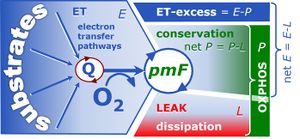Difference between revisions of "E-P excess capacity"
From Bioblast
| Line 4: | Line 4: | ||
|info=[[Gnaiger 2014 MitoPathways]] | |info=[[Gnaiger 2014 MitoPathways]] | ||
}} | }} | ||
{{MitoPedia | {{MitoPedia concepts | ||
|mitopedia | |mitopedia concept=Respiratory state | ||
}} | }} | ||
{{MitoPedia methods}} | |||
{{MitoPedia O2k and high-resolution respirometry}} | |||
{{MitoPedia topics}} | |||
[[Image:EPL-free and excess.jpg|right|300px|thumb|file=Gnaiger_2014_MitoPathways|[[Gnaiger 2014 MitoPathways |The Blue Book 2014]]: Fig. 2.4.]] | [[Image:EPL-free and excess.jpg|right|300px|thumb|file=Gnaiger_2014_MitoPathways|[[Gnaiger 2014 MitoPathways |The Blue Book 2014]]: Fig. 2.4.]] | ||
== Related terms in Bioblast == | == Related terms in Bioblast == | ||
Revision as of 12:58, 8 February 2016
Description
![]() The excess E-P capacity, ExP, is the difference of the ETS capacity and OXPHOS capacity, ExP = E-P. At ExP > 0, the capacity of the phosphorylation system exerts a limiting effect on OXPHOS capacity. In addition, ExP depends on coupling efficiency, since P approaches E at increasing uncoupling.
The excess E-P capacity, ExP, is the difference of the ETS capacity and OXPHOS capacity, ExP = E-P. At ExP > 0, the capacity of the phosphorylation system exerts a limiting effect on OXPHOS capacity. In addition, ExP depends on coupling efficiency, since P approaches E at increasing uncoupling.
Abbreviation: ExP
Reference: Gnaiger 2014 MitoPathways
MitoPedia concepts:
Respiratory state

The Blue Book 2014: Fig. 2.4.
Related terms in Bioblast
![]() OXPHOS, P
OXPHOS, P
![]() ROUTINE, R
ROUTINE, R
![]() ETS, E
ETS, E
![]() LEAK, L
LEAK, L
 ROX, R
ROX, R
- Free OXPHOS capacity, ≈P = P-L
- Free ROUTINE activity, ≈R = R-L
- Free ETS capacity, ≈E = E-L
- Excess E-P capacity, ExP = E-P
- Excess E-R capacity, ExR = E-R
